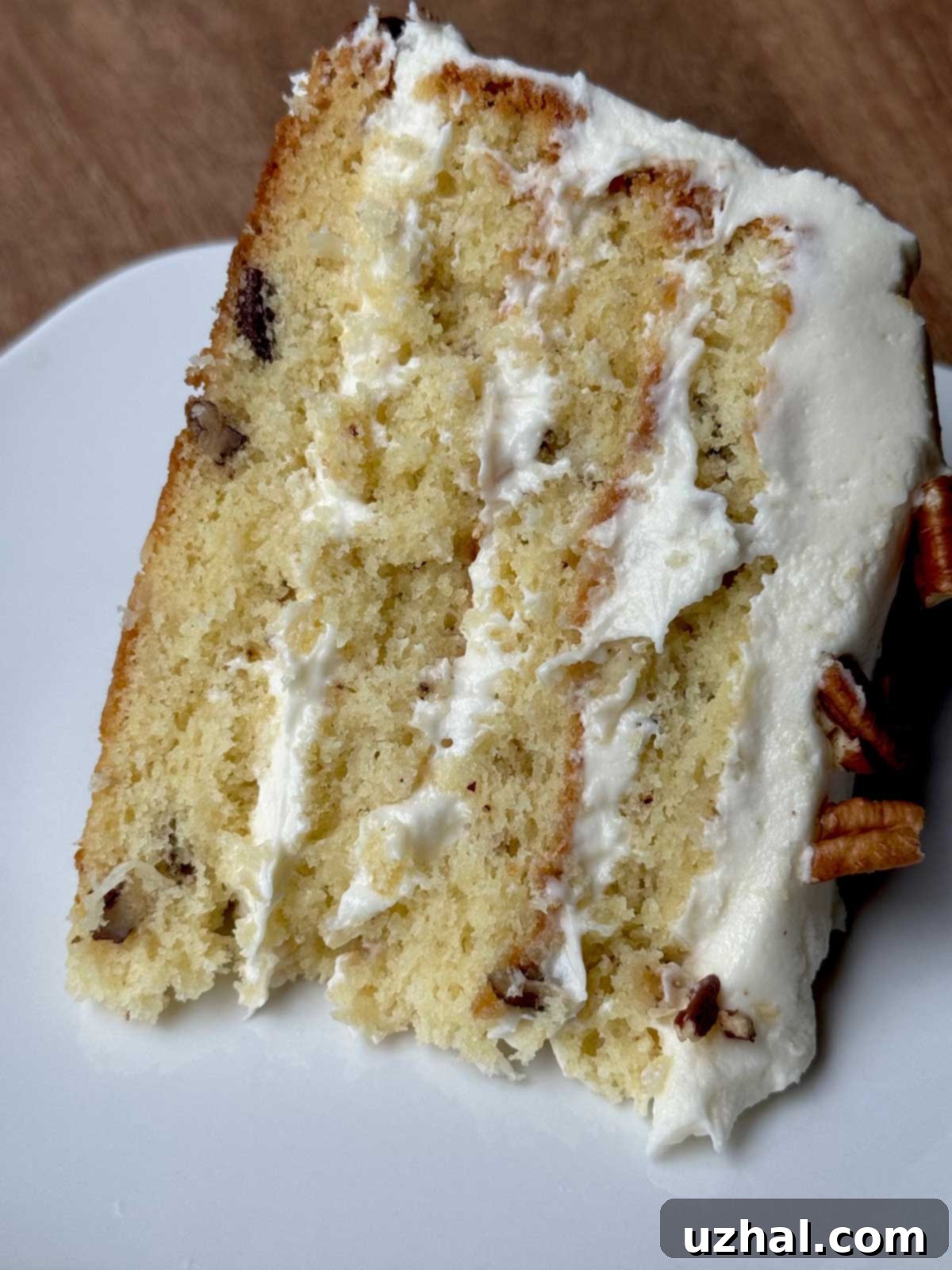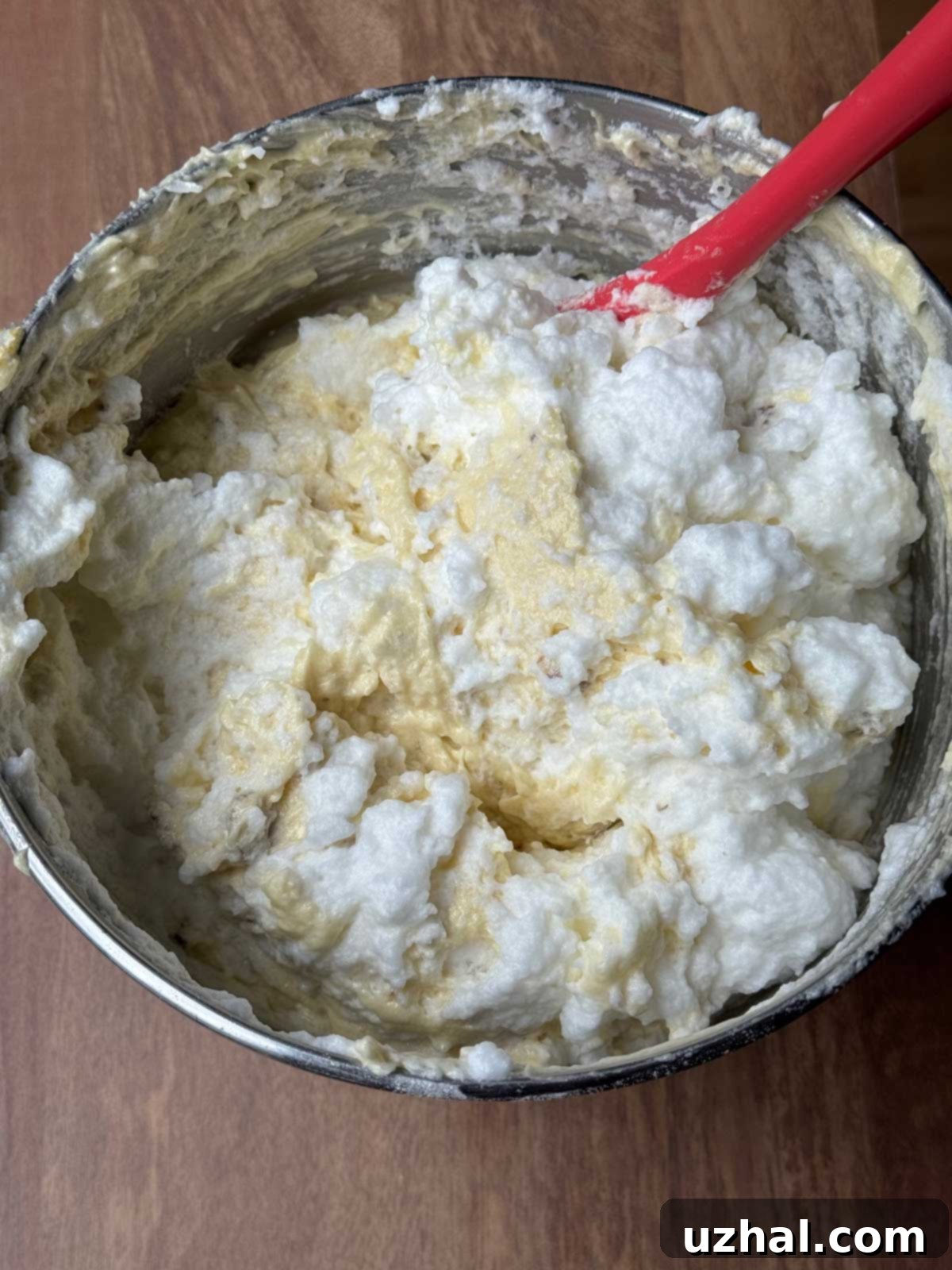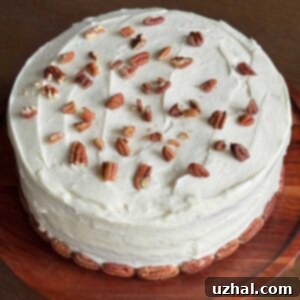Classic Italian Cream Cake Recipe: A Beloved Southern Dessert Tradition with Texas Roots
The name “Italian Cream Cake” might conjure images of sun-drenched European kitchens, but this exquisite dessert actually boasts a fascinating history deeply rooted in the American South, particularly Texas. Renowned for its incredibly soft, moist, and tender crumb, this three-layer cake is a true celebration of Southern flavors and textures. Its signature ingredients – rich cream cheese, crunchy pecans, sweet coconut, and tangy buttermilk – are staples in many beloved Southern dessert recipes, making its unexpected origin story all the more intriguing. This isn’t just any cake; it’s a culinary journey, offering a delightful balance of richness and delicate sweetness, crowned with a luscious cream cheese frosting that truly sets it apart.

The Curious Origins: From Canadian Cookbooks to Texas Tables
The journey of the Italian Cream Cake to its current status as a Southern classic is surprisingly complex and captivating. While it found its true fame in Texas, the earliest known printed recipe for a cake resembling our modern Italian Cream Cake actually appeared much further north, in a Canadian publication in 1913. How did a Canadian recipe adopt the “Italian” moniker and become a Southern institution? It’s a question that sparks much debate among culinary historians.
The cake’s widespread popularity truly began to soar in the United States after its appearance in the Plano News in 1937. This period was pivotal, as refrigerators were becoming commonplace in American homes, gradually replacing traditional ice boxes. This technological shift made cream cheese a much more accessible and popular ingredient for everyday baking. Suddenly, home bakers had the means to create rich, creamy frostings that were previously challenging to store and work with. The smooth, tangy cream cheese frosting, often described as “Mascarpone inspired” due to its luxurious texture, became a defining characteristic of this cake. The “Italian” in its name likely refers to a perception of sophistication, richness, or a certain elegance associated with Italian desserts, rather than a direct lineage to Italian culinary traditions. It’s a testament to how local adaptations and popular culture can reshape a dish’s identity over time.
Despite its rich heritage and undeniable deliciousness, you might not frequently spot Italian Cream Cake on the menus of high-end restaurants. Its enduring appeal lies more within community gatherings, family celebrations, and local culinary scenes. It remains particularly popular in Texas and other states where pecans are widely grown and celebrated. Here, it’s a staple at potlucks, church functions, and is a favored offering by local caterers, showcasing its status as a cherished homemade treat rather than a commercial dessert. It embodies the warmth and hospitality of Southern baking, a dessert made with love and shared generously.
The Essence of Italian Cream Cake: Perfecting Ratios and Texture
Achieving the quintessential texture of an Italian Cream Cake is all about precision and understanding the role of each ingredient. The most common and beloved recipes, particularly those found in my many Texas cookbooks, call for a specific blend of fats: butter and shortening. While some variations opt for an all-butter approach, the inclusion of shortening is key to elevating this cake. Shortening, being 100% fat, contributes to a lighter, more tender crumb and helps the cake layers bake up with a delicate fluffiness that butter alone can’t quite achieve. This combination ensures a cake that is incredibly moist yet structurally sound, a delicate balance that is essential for building a beautiful, tall dessert.
Mastering Traditional Italian Cream Cake Ratios
The traditional Italian Cream Cake typically adheres to a classic ratio that yields its signature qualities. Common measurements usually include 2 cups of all-purpose flour, 2 cups of granulated sugar, a half-cup combination of shortening and butter (each ½ cup), 5 large eggs (separated), and a cup of buttermilk. This precise combination is what makes the cake incredibly moist without being mushy. It’s a paradox: simultaneously dense and light, a characteristic achieved through careful mixing and the incorporation of whipped egg whites.
One of the beauties of this cake is that the layers often bake up remarkably flat, which is incredibly helpful when you’re assembling a multi-tiered cake. However, these layers are also quite light and thin, making them susceptible to sinking in the middle if the ingredients aren’t perfectly balanced or if the batter is over or undermixed. The buttermilk provides a crucial tang and reacts with the baking soda to create lift, while the separated eggs contribute structure and richness. The egg whites, whipped to stiff peaks and gently folded into the batter, are paramount for that signature airy yet substantial texture. Every component plays a vital role in crafting this iconic Southern delicacy.

While I’ve made this Italian Cream Cake recipe several times since first discovering it, its sheer size often means it’s reserved for special occasions rather than a regular rotation. It’s a truly generous cake, yielding three or even four layers, perfect for feeding a crowd. The effort is always rewarded with rave reviews and satisfied smiles. I genuinely hope to find more opportunities to bake and share this magnificent dessert in the future. Its timeless appeal makes it a standout choice for any festive gathering.
If you’re looking to enjoy the deliciousness of Italian Cream Cake on a smaller scale, perhaps for a more intimate setting, there are fantastic options available. Here’s a link to a recipe for a six-inch Mini Italian Cream Cake, perfect for those times when you crave this classic but don’t need a grand, multi-layer creation. It offers all the flavor without the commitment of a full-sized cake.
A Few Essential Baking Tips for Italian Cream Cake Perfection
To ensure your Italian Cream Cake turns out as spectacular as it should, pay attention to these tried-and-true tips. These insights, gleaned from years of baking experience, will help you achieve a moist crumb, perfectly balanced flavors, and a show-stopping presentation.
- Layer Configuration: Traditionally, Italian Cream Cake is made with three layers to best showcase the generous amount of cream cheese frosting between each tier. If you don’t have three 9-inch round cake pans, don’t fret! You can easily bake two 9-inch layers and then carefully split each layer horizontally to create a four-layer cake. Alternatively, if you prefer a higher cake-to-frosting ratio, simply make two thicker 9-inch layers. Just remember that baking time will need to be adjusted; for two thicker layers, expect approximately 35-40 minutes at 325°F.
- Enhancing the Flavor Profile: While pure vanilla extract is indispensable for its warm, classic aroma, I often like to bump up the flavor slightly with the addition of a half-teaspoon of almond extract. This subtle nutty note complements the pecans and coconut beautifully, adding another layer of complexity to the cake. Feel free to adjust or omit it based on your preference – using just vanilla will still yield a delicious result.
- Choosing the Right Shortening: For the best results when using shortening, I recommend brands like Spectrum. High-quality shortening contributes significantly to the cake’s tender crumb and helps maintain its structure, especially when combined with butter.
- The Buttermilk Advantage: Real, cultured buttermilk delivers a superior flavor and acidity that is crucial for this recipe. If true buttermilk is unavailable, a homemade substitute (adding 1 tablespoon of lemon juice or white vinegar to a cup of whole milk and letting it sit for 5-10 minutes until it curdles) works in a pinch. However, strive for authentic whole buttermilk for that authentic tangy depth and optimal reaction with the baking soda. Always ensure your buttermilk is at room temperature before adding it to the batter to prevent the butter/shortening mixture from seizing.
- Frosting Abundance: This recipe makes what seems like a generous amount of cream cheese frosting, but trust me, you’ll need every bit of it! The traditional Italian Cream Cake is known for its thick, luscious layers of frosting between each cake tier and coating the entire exterior. Don’t be shy when frosting. Additionally, taste the frosting before you finish; a small pinch more salt can beautifully balance the sweetness, preventing it from being cloyingly sweet and enhancing all the other flavors.
- Room Temperature Ingredients: Ensure all your cold ingredients like butter, cream cheese, and eggs are at true room temperature. This allows them to cream together smoothly and emulsify properly, creating a uniform batter and a light, even texture in your finished cake.
- Don’t Overmix: After adding the flour and buttermilk mixture, mix just until combined. Overmixing can develop the gluten in the flour too much, leading to a tough cake. The final folding in of the egg whites should also be gentle to preserve airiness.
- Cool Completely: Before frosting, make sure your cake layers are absolutely cool. Frosting a warm cake is a recipe for disaster, as the frosting will melt and slide off, making it impossible to decorate nicely.
- Explore other delightful Cream Cake recipes like our Hazelnut Cream Cake
- Discover more beloved bakes from our Favorite Recipes from 2019
- Indulge in the rich flavors of Italian Love Cake
- Try our charming Italian Rock Cookies for a simpler treat
Recipe: The Ultimate Italian Cream Cake

Italian Cream Cake
Anna
Pin Recipe
Ingredients
For the Italian Cream Cake:
- 1 stick unsalted butter (114 grams), softened to room temperature
- ½ cup shortening (96 grams), at room temperature
- 2 cups granulated sugar (400 grams)
- ½ teaspoon salt
- 5 large eggs, separated (at room temperature)
- 1 teaspoon vanilla extract
- ½ teaspoon almond extract (optional, or use an additional ½ tsp vanilla)
- 1 teaspoon baking soda
- 1 cup buttermilk (at room temperature for best results)
- 2 cups all-purpose flour (265 grams), sifted
- ⅔ cup pecans, toasted and chopped
- 1 cup sweetened angel flake coconut or unsweetened coconut
For the Cream Cheese Frosting:
- 12 tablespoons unsalted butter, softened (at room temperature)
- 12 oz cream cheese, softened (full-fat, at room temperature)
- 2 teaspoons vanilla extract
- ¼ teaspoon salt, plus more to taste if necessary
- 5 ½ cups powdered sugar, sifted after measuring (approximately 1 ½ pounds)
Instructions
Cake Preparation
-
Preheat your oven to 325°F (160°C). Prepare three 9-inch round cake pans by generously greasing and flouring them. Alternatively, if you only have two 9-inch pans, you can grease and flour two pans, bake thicker layers, and then carefully split them horizontally once cooled to create four layers.
-
In the bowl of a stand mixer fitted with the paddle attachment, cream together the softened butter, shortening, granulated sugar, and salt. Beat on medium-high speed for 3-5 minutes, until the mixture is light and fluffy. Add the egg yolks one at a time, beating well after each addition to fully incorporate. Scrape down the sides of the bowl frequently to ensure everything is evenly mixed. Beat in the vanilla extract and almond extract (if using).
-
In a separate small bowl, stir the baking soda into the room temperature buttermilk until it fully dissolves. The buttermilk will become slightly bubbly as it reacts with the baking soda.
-
Reduce the mixer speed to the lowest setting. Gradually add the sifted flour and the buttermilk mixture alternately to the creamed butter mixture, beginning and ending with flour. Mix just until combined and no streaks of flour remain. Be careful not to overmix.
-
By hand, gently fold in the toasted chopped pecans and coconut into the batter until evenly distributed.
-
In a separate, clean mixing bowl, beat the reserved egg whites with clean beaters until they form stiff peaks. Gently fold these whipped egg whites into the cake batter in two additions, taking care not to deflate the air. This step is crucial for the cake’s light texture.
-
Divide the batter evenly between your prepared cake pans.
-
Bake at 325°F (160°C) for 25-30 minutes for three layers, or 30-35 minutes if baking two thicker layers, or until a wooden skewer inserted into the center comes out clean. Let the cakes cool in their pans on a wire rack for about 10 minutes, then invert them onto the rack to cool completely before frosting. Ensure they are completely cool to the touch.
Cream Cheese Frosting
-
In the bowl of a stand mixer, cream the softened butter and cream cheese together until smooth and lump-free, about 2-3 minutes. Add the vanilla extract and ¼ teaspoon of salt, mixing well. Gradually add the sifted powdered sugar, one cup at a time, beating on low speed until fully incorporated. Once all sugar is added, increase speed to medium-high and beat until the frosting is light, fluffy, and well blended. Taste and add a tiny pinch more salt if you feel it needs it to balance the sweetness.
-
Once your cake layers are completely cool, generously frost and stack them. For an elegant finish, garnish the top and sides of the cake with additional toasted chopped pecans or coconut flakes. Slice and serve this magnificent Italian Cream Cake to your delighted guests!
